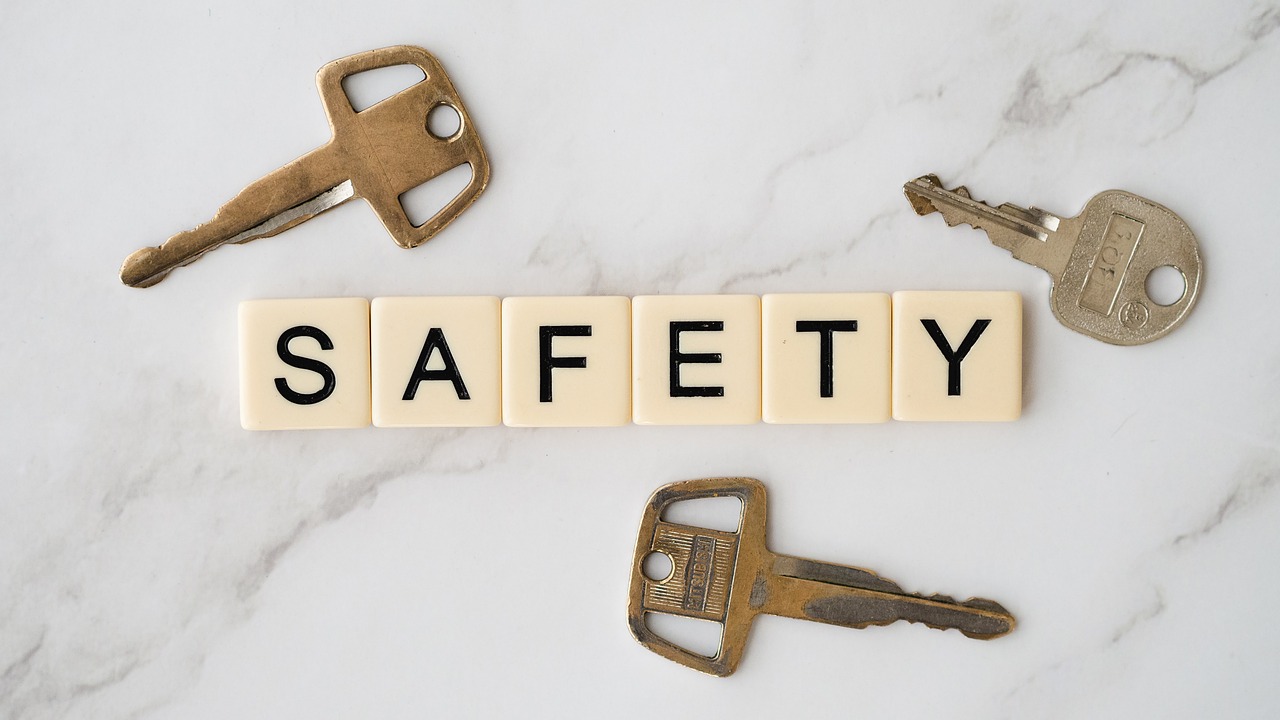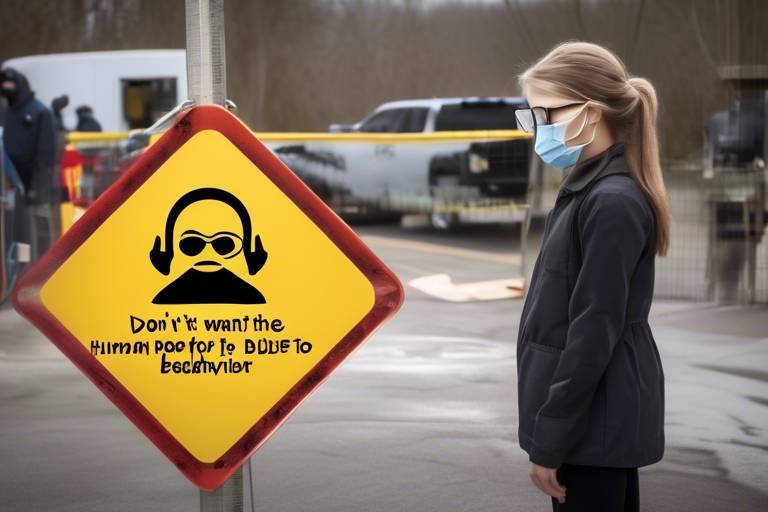Safety Regulations: Influencing and Influenced by Human Behavior
In today's fast-paced world, safety regulations are not just a set of rules we follow; they are a reflection of our collective understanding of risk and responsibility. They are designed to protect us, yet their effectiveness largely hinges on human behavior. Think about it: how often do we see safety protocols in place, only to find people ignoring them? This paradox raises an intriguing question: do safety regulations shape our behavior, or do our behaviors shape the regulations themselves? This article dives deep into this dynamic relationship, exploring the intricate dance between safety regulations and human actions across various environments.
Understanding how human behavior affects compliance with safety regulations is crucial for developing effective strategies to enhance workplace safety and reduce accidents. Imagine a workplace where every employee adheres to safety protocols without question. Sounds ideal, right? However, the reality is often different. Many factors influence whether individuals follow safety guidelines, including their perceptions, motivations, and even the organizational culture they are part of. By examining these elements, we can better grasp the nuances of safety compliance and create environments that foster adherence to regulations.
When we talk about safety, we can't overlook the psychological aspects that play a significant role in how individuals perceive and adhere to safety regulations. These factors include risk perception, motivation, and past experiences, all of which can profoundly influence behavior. For instance, if someone perceives a task as low-risk, they may be less inclined to follow safety protocols. Conversely, a heightened sense of risk can lead to increased adherence. Understanding these psychological factors is essential for creating effective safety regulations that resonate with individuals on a deeper level.
Examining how individuals assess risks can provide insights into their decision-making processes regarding safety practices and adherence to regulations. Risk perception is not just about understanding potential dangers; it’s about how individuals emotionally respond to those dangers. For example, a construction worker may feel invulnerable to accidents due to overconfidence, leading to risky behavior. On the other hand, someone who has witnessed a serious accident may become overly cautious, sometimes to the detriment of productivity. This interplay between perception and decision-making is critical in shaping safety behaviors.
Effective training programs can significantly alter individuals' risk perception, leading to improved compliance with safety regulations in various settings. Training isn't just about teaching rules; it's about creating awareness and fostering a mindset that prioritizes safety. A well-structured training program can transform an employee's understanding of risks, making them more likely to adhere to safety practices. For instance, hands-on training that simulates real-life scenarios can be particularly effective in enhancing risk perception and promoting safer behaviors.
Past experiences, whether positive or negative, can shape an individual's attitude toward safety regulations and influence future behavior in similar situations. If someone has previously experienced a near-miss incident, they are likely to approach safety with greater caution in the future. On the flip side, a lack of negative experiences can lead to complacency. This highlights the importance of sharing stories and experiences within organizations to create a collective understanding of safety risks and reinforce the importance of compliance.
Understanding what motivates individuals to comply with safety regulations can help organizations design better safety programs that resonate with employees. Motivation can come from various sources, including intrinsic factors like personal values and extrinsic factors like rewards or recognition. Organizations should strive to create a motivating environment where employees feel valued for adhering to safety protocols. For example, implementing a reward system for teams that demonstrate exceptional safety compliance can encourage a culture of safety and motivate individuals to prioritize regulations.
The culture within an organization plays a pivotal role in shaping employee behavior and their adherence to safety regulations. A strong safety culture is characterized by shared values, beliefs, and practices that prioritize safety at all levels. When employees feel that their organization genuinely cares about their well-being, they are more likely to comply with safety regulations. This cultural alignment creates a ripple effect, where safety becomes an integral part of the organizational identity.
Promoting a culture that prioritizes safety can enhance compliance and encourage proactive behavior among employees regarding safety regulations. This involves not only implementing safety protocols but also fostering open communication about safety concerns. Employees should feel empowered to voice their opinions and report unsafe conditions without fear of retribution. A safety-first culture can be cultivated through regular safety meetings, workshops, and team-building exercises that emphasize the importance of safety in everyday operations.
Leadership commitment to safety can significantly influence employee behavior and the overall effectiveness of safety regulations within an organization. When leaders demonstrate a genuine commitment to safety, it sets the tone for the entire organization. Employees are more likely to follow suit when they see their leaders actively engaging in safety practices and prioritizing safety in decision-making processes. This leadership involvement can take many forms, from participating in safety training to recognizing and rewarding safe behaviors.
Implementing feedback mechanisms is essential for understanding the effectiveness of safety regulations and making necessary adjustments based on human behavior. Feedback systems allow organizations to gather insights from employees about safety practices and potential areas for improvement. This continuous feedback loop creates an environment where safety is not static but evolves based on real-world experiences and challenges.
Effective reporting systems encourage employees to share safety concerns and incidents, fostering a culture of continuous improvement in safety practices. When employees feel safe to report issues without fear of punishment, it leads to a more transparent and proactive approach to safety. Organizations can analyze reported incidents to identify patterns and address underlying issues that may compromise safety.
Analyzing data collected from feedback systems can help organizations identify trends and areas for improvement in safety regulations and practices. By leveraging data analytics, organizations can pinpoint specific risks, evaluate the effectiveness of safety protocols, and implement targeted interventions. This data-driven approach not only enhances safety but also demonstrates a commitment to continuous improvement, which is crucial in today’s ever-evolving work environments.
- What are safety regulations? Safety regulations are rules and guidelines established to ensure the safety and health of individuals in various environments, particularly workplaces.
- How do human behaviors influence safety regulations? Human behaviors can impact the effectiveness of safety regulations by determining whether individuals comply with them or not, often shaped by perceptions, motivations, and past experiences.
- Why is organizational culture important for safety compliance? A strong organizational culture that prioritizes safety encourages employees to adhere to safety regulations, fostering a proactive approach to safety within the workplace.
- How can feedback mechanisms improve safety regulations? Feedback mechanisms allow organizations to gather insights from employees, enabling them to identify areas for improvement and create a more effective safety framework.

The Role of Human Behavior in Safety Compliance
When it comes to safety compliance, human behavior plays a critical role that cannot be overlooked. Imagine a workplace where every employee strictly adheres to safety regulations. Sounds ideal, right? However, the reality is often different. Human behavior is influenced by a myriad of factors, including personal beliefs, past experiences, and even the organizational culture surrounding them. Understanding these influences is essential for organizations aiming to enhance workplace safety and reduce the risk of accidents.
One significant aspect of human behavior in safety compliance is the tendency to underestimate risks. Many individuals often think, "It won't happen to me," leading them to take unnecessary risks. This common mindset can be detrimental, as it creates a false sense of security. To combat this, organizations must actively promote a culture of safety that emphasizes the importance of adhering to safety regulations. When employees understand that their actions have real consequences, they are more likely to comply with safety protocols.
Moreover, the effectiveness of safety compliance is also influenced by the level of training provided to employees. Training programs that engage employees and provide practical scenarios can shift their perceptions of risk and enhance their understanding of safety regulations. For instance, hands-on training sessions that simulate real-life situations can make employees more aware of potential hazards, thereby increasing their likelihood of following safety guidelines.
Another vital factor is the role of motivation in compliance. Employees are more inclined to adhere to safety regulations when they feel valued and recognized for their efforts. Organizations can foster this motivation by implementing reward systems or recognition programs that highlight safe practices. When employees see that their commitment to safety is appreciated, they are more likely to maintain compliance.
In summary, human behavior is at the heart of safety compliance. By understanding the psychological factors that influence behavior, organizations can develop strategies that not only promote adherence to safety regulations but also create a culture where safety is a shared responsibility. This dual approach can transform the workplace into a safer environment for everyone.
- What are the main factors influencing human behavior in safety compliance?
Human behavior in safety compliance is influenced by personal beliefs, past experiences, training, and the organizational culture. - How can organizations improve safety compliance?
Organizations can improve safety compliance by providing effective training, fostering a safety-first culture, and recognizing employees for their commitment to safety. - Why is risk perception important in safety compliance?
Risk perception is crucial because it shapes how individuals assess potential dangers and influences their decision-making regarding safety practices.

Psychological Factors Affecting Safety Regulations
When it comes to safety regulations, the human mind plays a fascinating role. It's not just about rules on paper; it's about how we perceive and react to those rules in real life. Understanding the psychological factors that influence our behavior towards safety regulations is crucial. Why? Because these factors can make or break the effectiveness of the regulations themselves. For instance, if someone feels invincible or believes that accidents only happen to others, they might disregard safety measures. This brings us to the importance of risk perception and motivation in shaping our compliance with safety protocols.
Risk perception is essentially how we assess potential dangers in our environment. It's like looking at a roller coaster and deciding whether to ride it based on how scary it looks. Individuals often weigh the likelihood of an accident against the perceived benefits of taking risks. This process can be heavily influenced by various factors, such as previous experiences, peer opinions, and even media portrayals of accidents. For example, if someone has witnessed a serious incident at work, their perception of risk might shift dramatically, leading them to adhere more strictly to safety regulations. On the flip side, if they’ve never seen an accident, they might underestimate the potential dangers.
Training programs are pivotal in altering risk perception. Think of them as the safety glasses that help you see the hazards more clearly. When employees undergo comprehensive training, they not only learn the rules but also understand the reasoning behind them. This understanding can lead to a significant change in how they perceive risks. For instance, a construction worker who has been trained on the dangers of falling from heights is more likely to use harnesses and safety nets than someone who hasn't received such training. Effective training not only informs but also empowers individuals to make safer choices.
Our past experiences shape our attitudes towards safety regulations in profound ways. If an individual has had a negative experience, such as an injury due to negligence, they are likely to develop a heightened awareness of safety measures. Conversely, someone who has never faced any issues may become complacent. This psychological impact can lead to a cycle where positive experiences reinforce safe behaviors, while negative experiences lead to stricter adherence to safety protocols. It’s essential for organizations to recognize this influence and create environments where positive safety experiences are the norm.
Now, let’s dive into what really drives individuals to comply with safety regulations. It’s not just about fear of punishment; it’s also about personal motivation. Employees are more likely to follow safety protocols if they feel a sense of ownership over their safety and the safety of their colleagues. This can be fostered through various means, such as recognition programs, where employees are rewarded for adhering to safety practices. Additionally, fostering an environment where safety is a shared responsibility can enhance motivation. When the entire team is committed to safety, individuals are more likely to follow suit.
In conclusion, psychological factors play a pivotal role in how safety regulations are perceived and followed. By understanding risk perception and the impact of past experiences, organizations can tailor their safety programs to address these psychological aspects effectively. This not only enhances compliance but also promotes a safer workplace culture overall.
- How can organizations improve compliance with safety regulations?
Organizations can enhance compliance by implementing effective training programs, fostering a safety-first culture, and encouraging open communication about safety concerns.
- What role does leadership play in safety compliance?
Leadership sets the tone for safety culture within an organization. When leaders prioritize safety, employees are more likely to follow suit.
- How does past experience influence safety behavior?
Past experiences, especially negative ones, can significantly impact an individual's attitude towards safety regulations, leading to either increased vigilance or complacency.

Risk Perception and Decision-Making
When it comes to safety regulations, understanding risk perception is crucial. It's like walking a tightrope; one misstep can lead to disaster. Individuals often assess risks based on their past experiences, knowledge, and even emotional responses. This subjective evaluation can significantly impact their decision-making processes regarding safety practices. For instance, someone who has witnessed a workplace accident may perceive risks differently than someone who hasn't. This disparity can lead to varying levels of compliance with safety regulations. So, how do we bridge this gap?
To tackle this, organizations need to foster an environment where employees feel comfortable discussing their perceptions of risk. Regular training sessions can help reshape how individuals view safety risks. By providing real-life examples and engaging scenarios, employees can better understand the implications of their actions. It's not just about following rules; it's about recognizing the importance of safety in their daily tasks. Imagine a world where every employee feels empowered to make safe choices, not just because they have to, but because they genuinely understand the risks involved.
Moreover, the decision-making process is often influenced by several psychological factors, including cognitive biases. For instance, the optimism bias leads individuals to believe that they are less likely to experience negative outcomes than others. This can result in a lax attitude towards safety regulations. To counteract this, organizations can implement strategies such as:
- Regular safety drills to reinforce the importance of compliance.
- Incorporating feedback from employees to understand their concerns and perceptions.
- Utilizing visual aids and reminders to keep safety at the forefront of everyone's mind.
In essence, enhancing risk perception among employees is not just about imparting knowledge; it's about creating a culture where safety is a shared responsibility. By understanding how individuals make decisions based on their perception of risk, organizations can tailor their safety programs to be more effective. This proactive approach not only reduces accidents but also fosters a more engaged and safety-conscious workforce.

Influence of Training on Risk Perception
Training plays a critical role in shaping how individuals perceive risks in their environment. When employees undergo comprehensive safety training, they are not just learning rules; they are gaining a deeper understanding of the potential dangers associated with their tasks. This knowledge transforms their perception of risk from a vague concept into a tangible reality. For instance, consider a construction worker who has been trained on the proper use of safety harnesses. Before training, they might have underestimated the risk of falling from heights. However, after participating in a hands-on training session, they become acutely aware of the dangers and the importance of using safety gear. This shift in perception can significantly influence their behavior on the job site.
Moreover, effective training programs often incorporate real-life scenarios and simulations that allow employees to experience risks in a controlled environment. This experiential learning can be much more impactful than traditional lectures or written guidelines. By facing simulated risks, employees can develop a more accurate understanding of how to respond in actual situations. This is akin to learning to swim by jumping into the pool rather than just reading about it. The practical experience solidifies their knowledge and prepares them for real-world challenges.
Additionally, training should not be a one-time event. Continuous training and refresher courses are essential to keep safety at the forefront of employees' minds. Regular updates on safety protocols can help maintain a high level of awareness regarding risks. Organizations that invest in ongoing training demonstrate a commitment to their employees' safety, fostering a culture where safety is prioritized. This, in turn, can enhance compliance with safety regulations as employees feel more prepared and confident in their ability to manage risks.
To illustrate the impact of training on risk perception, consider the following table that summarizes key elements of effective safety training programs:
| Training Element | Description | Impact on Risk Perception |
|---|---|---|
| Hands-On Experience | Practical exercises that simulate real-life scenarios. | Enhances understanding of risks and proper responses. |
| Regular Updates | Ongoing training sessions to reinforce safety protocols. | Keeps safety top-of-mind, reducing complacency. |
| Feedback Mechanisms | Encouraging employees to share experiences and concerns. | Promotes a culture of safety and continuous improvement. |
In summary, the influence of training on risk perception is profound. By providing employees with the tools, knowledge, and experiences necessary to understand risks, organizations can foster a safer work environment. This not only leads to improved compliance with safety regulations but also cultivates a workforce that is genuinely invested in maintaining a culture of safety. After all, when individuals feel empowered through training, they are more likely to take proactive measures to protect themselves and their colleagues.
- What is the primary goal of safety training? The primary goal of safety training is to educate employees about potential hazards and the best practices to mitigate risks, ensuring a safer work environment.
- How often should safety training be conducted? Safety training should be conducted regularly, with refresher courses at least annually or whenever there are changes in procedures or regulations.
- Can training alone improve safety compliance? While training is essential, it must be coupled with a strong safety culture and leadership commitment to achieve meaningful improvements in compliance.
- What role does feedback play in safety training? Feedback allows organizations to identify gaps in training and improve programs based on employee experiences and suggestions, fostering a culture of continuous improvement.

Impact of Past Experiences on Behavior
When it comes to understanding safety regulations, one cannot overlook the profound impact of past experiences on individual behavior. Think of it like this: if you’ve ever had a close call while driving, you might find yourself more cautious behind the wheel in the future. This is a classic example of how our past experiences can shape our approach to safety. Whether it's a workplace incident or a near-miss situation, these experiences create a mental framework that influences how we perceive and respond to safety regulations.
Our brains are wired to learn from experiences, and this learning can manifest in various ways. For instance, an employee who witnessed a colleague getting injured due to negligence may develop a heightened awareness of safety protocols. They might start adhering to regulations more strictly, not just for their own safety but also out of a sense of responsibility towards their peers. On the flip side, if someone has never encountered a safety issue, they might underestimate risks, believing that regulations are unnecessary. This disparity highlights the complex relationship between personal history and compliance with safety standards.
Moreover, the emotional weight of past experiences can’t be ignored. Negative incidents often lead to feelings of fear or anxiety, which can either motivate individuals to comply with safety regulations or, conversely, lead to avoidance behavior. For example, if an employee feels overwhelmed by the fear of making a mistake after a previous incident, they might either become overly cautious or, in some cases, disengaged from following safety protocols altogether. This duality illustrates the importance of addressing emotional responses when designing training and safety programs.
To better understand this concept, consider the following factors that play a role in how past experiences influence behavior:
- Learning from Mistakes: Individuals who have learned from their past mistakes are often more vigilant about safety regulations.
- Peer Influence: Observing colleagues' reactions to past incidents can shape one’s own attitudes towards safety compliance.
- Emotional Responses: Negative experiences can lead to heightened awareness, while positive experiences might foster complacency.
Organizations can leverage this understanding by implementing targeted training programs that incorporate scenarios based on past experiences. By discussing real-life incidents, employees can better grasp the implications of safety regulations and learn how to navigate similar situations in the future. Additionally, creating an environment where employees feel comfortable sharing their experiences can foster a culture of safety and continuous improvement.
In summary, the impact of past experiences on behavior is a crucial element in the realm of safety regulations. By recognizing this influence, organizations can tailor their safety programs to not only educate but also resonate with employees on a personal level. This approach not only enhances compliance but also cultivates a proactive attitude towards safety, ultimately leading to a safer work environment for everyone.
- How can past experiences affect safety compliance? Past experiences shape our perceptions and reactions to safety regulations, influencing our behavior in both positive and negative ways.
- What role does emotional response play in safety behavior? Emotional responses to past incidents can either motivate individuals to comply with safety protocols or lead to avoidance behavior.
- How can organizations use past experiences in training? Organizations can incorporate real-life scenarios from past incidents into training programs to enhance understanding and compliance with safety regulations.

Motivational Factors for Compliance
Understanding what drives individuals to comply with safety regulations is essential for creating effective safety programs. When we think about motivation, it’s not just about enforcing rules; it’s about tapping into what makes people tick. Why do some employees strictly adhere to safety protocols while others take shortcuts? The answer lies in a blend of intrinsic and extrinsic factors that influence behavior.
One of the most significant intrinsic motivators is the desire for personal safety. Employees are more likely to follow safety regulations if they genuinely believe that these measures protect them from harm. This belief can be fostered through effective communication about the risks associated with non-compliance. For instance, sharing real-life stories of accidents that occurred due to negligence can create a sense of urgency and personal connection to safety practices.
On the other hand, extrinsic motivators come into play through rewards and recognition. Organizations that implement incentive programs often see higher compliance rates. Consider a workplace where employees receive bonuses or public acknowledgment for maintaining a safe work environment. This not only boosts morale but also reinforces the behavior you want to see. A simple table below illustrates how different motivational factors can affect compliance:
| Motivational Factor | Type | Impact on Compliance |
|---|---|---|
| Personal Safety | Intrinsic | High |
| Financial Incentives | Extrinsic | Moderate to High |
| Peer Recognition | Extrinsic | Moderate |
| Training and Education | Intrinsic | High |
Moreover, training programs play a crucial role in enhancing motivation. When employees are educated about the importance of safety regulations and the potential consequences of neglecting them, they are more likely to internalize these lessons. It’s akin to planting a seed; with the right environment and care, it will grow into a strong tree. Regular training sessions not only keep safety protocols fresh in employees' minds but also empower them with the knowledge to make informed decisions.
Another critical factor is the involvement of employees in the creation of safety regulations. When workers feel that their opinions matter and that they have a say in the safety protocols that govern their work environment, they are more likely to comply. This sense of ownership fosters a culture where safety is a shared responsibility rather than just a top-down mandate.
In conclusion, understanding the motivational factors for compliance with safety regulations is not just about enforcing rules; it’s about creating an environment where safety becomes a part of the organizational culture. By addressing both intrinsic and extrinsic motivators, organizations can foster a safer workplace that not only meets regulatory requirements but also enhances employee well-being.
- What are intrinsic motivators for safety compliance? Intrinsic motivators include personal safety, the desire to protect oneself and colleagues, and the internal satisfaction that comes from adhering to safety protocols.
- How can organizations enhance extrinsic motivation? Organizations can enhance extrinsic motivation by implementing reward systems, recognition programs, and providing financial incentives for compliance with safety regulations.
- Why is employee involvement important in safety regulations? Employee involvement is crucial because it fosters a sense of ownership and responsibility, making workers more likely to comply with safety protocols.

Organizational Culture and Safety Regulations
The culture within an organization is like the air we breathe; it surrounds us, influences our actions, and shapes our perceptions. When it comes to safety regulations, this culture plays a pivotal role in determining how employees behave and adhere to these guidelines. A robust safety culture encourages individuals to prioritize safety, not just as a regulatory requirement but as a core value. Imagine a workplace where every employee feels responsible for their safety and that of their colleagues—this is the essence of a safety-first culture.
To create such an environment, organizations must actively promote safety as a fundamental aspect of their operations. This can be achieved through various strategies, including regular training sessions, open communication about safety issues, and the integration of safety into everyday practices. For instance, when employees see their leaders actively participating in safety drills or discussing safety measures in meetings, it sends a powerful message: safety is not just a checkbox; it’s a priority. This kind of leadership commitment is crucial in shaping a positive safety culture.
Moreover, the influence of organizational culture extends beyond mere compliance with safety regulations. It fosters an atmosphere where employees feel empowered to voice their concerns and suggest improvements. When people are encouraged to report near misses or unsafe conditions without fear of retribution, it leads to a more proactive approach to safety. This can be illustrated in the following table, which outlines the key elements of a strong safety culture:
| Key Element | Description |
|---|---|
| Leadership Commitment | Visible support from leaders reinforces the importance of safety. |
| Open Communication | Encouraging dialogue about safety concerns fosters trust and transparency. |
| Employee Involvement | Involving employees in safety discussions enhances ownership and accountability. |
| Continuous Training | Regular training keeps safety practices fresh and top-of-mind for everyone. |
Incorporating these elements into the organizational culture can lead to significant improvements in safety compliance. For example, organizations that prioritize safety culture often see a reduction in workplace accidents and injuries. It’s not just about following regulations; it’s about creating an environment where safety is intrinsic to the organizational identity.
Ultimately, a strong safety culture aligns the interests of both the organization and its employees. When workers feel valued and see that their safety is a priority, they are more likely to comply with safety regulations. This mutual benefit creates a cycle of improvement, where adherence to safety regulations becomes second nature, and the organization thrives as a result. So, let’s ask ourselves: what kind of safety culture are we fostering in our workplaces, and how can we enhance it for the benefit of everyone involved?
- What is organizational culture? Organizational culture refers to the shared values, beliefs, and practices that shape how members of an organization interact and work together.
- How does culture influence safety? A positive safety culture encourages employees to prioritize safety, report issues, and actively participate in safety initiatives, leading to better compliance with regulations.
- What role does leadership play in safety culture? Leadership sets the tone for safety culture by demonstrating commitment, providing resources, and encouraging open communication about safety concerns.
- How can organizations improve their safety culture? Organizations can improve safety culture by promoting open communication, involving employees in safety discussions, and providing continuous training and support.

Creating a Safety-First Culture
Creating a Safety-First Culture within an organization is not just a checkbox on a compliance form; it's a transformative approach that can change the very fabric of how employees perceive and engage with safety regulations. Imagine a workplace where every employee feels empowered to prioritize safety, not just because they have to, but because they genuinely want to. This shift doesn't happen overnight; it requires a concerted effort from all levels of the organization, starting from leadership down to every individual contributor.
At the heart of a safety-first culture is the belief that safety is everyone's responsibility. When employees understand that their actions can significantly impact their colleagues' well-being, they are more likely to take safety protocols seriously. This is where communication plays a crucial role. Open lines of communication encourage team members to voice their concerns, share insights, and report unsafe conditions without fear of repercussion. A culture that promotes transparency not only fosters trust but also enhances collective vigilance.
Furthermore, organizations should actively involve employees in the development and implementation of safety policies. When employees contribute to shaping the rules they follow, they are more likely to feel a sense of ownership and accountability. For instance, consider holding regular safety meetings where team members can discuss potential hazards and brainstorm solutions. This collaborative approach not only improves safety measures but also strengthens team cohesion.
Training is another essential component of cultivating a safety-first culture. Regular and engaging training sessions can help employees understand the importance of safety regulations and how they apply to their specific roles. Instead of viewing safety training as a tedious requirement, organizations can make it interactive and relevant. For example, utilizing real-life scenarios and role-playing exercises can enhance learning and retention, making safety practices second nature to employees.
Moreover, recognizing and rewarding safe behavior can significantly boost morale and encourage compliance. Acknowledging employees who consistently follow safety protocols reinforces the idea that safety is valued and appreciated within the organization. This can be as simple as a shout-out in a team meeting or a more formal recognition program. When employees see that their commitment to safety is celebrated, they are more likely to continue prioritizing it in their daily activities.
In conclusion, creating a safety-first culture is a multifaceted endeavor that requires dedication, communication, and active participation from all members of the organization. By fostering an environment that prioritizes safety, organizations can not only comply with regulations but also create a workplace where employees feel valued and protected. This proactive approach not only reduces accidents but also enhances overall productivity and employee satisfaction.
- What is a safety-first culture?
A safety-first culture is an organizational approach that prioritizes safety in all aspects of operations, ensuring that employees feel responsible and empowered to maintain safe practices. - How can leadership influence safety culture?
Leadership can influence safety culture by demonstrating commitment to safety through actions, communication, and by actively involving employees in safety discussions and decisions. - Why is employee involvement important in safety programs?
Employee involvement is crucial because it fosters ownership and accountability, leading to greater compliance and a proactive approach to safety. - What role does training play in a safety-first culture?
Training provides employees with the knowledge and skills necessary to understand and adhere to safety regulations, making safety practices second nature.

Leadership’s Role in Shaping Safety Culture
When we talk about safety culture in the workplace, we can't overlook the significant impact that leadership has on shaping it. Imagine a ship sailing through turbulent waters; the captain's decisions and demeanor determine whether the crew feels secure or anxious. Similarly, leaders set the tone for how safety is perceived and prioritized within an organization. Their actions, words, and commitment to safety can create a ripple effect that influences every employee's behavior.
Effective leaders understand that safety is not just a checklist item; it is a core value that should be woven into the fabric of the organization. They lead by example, demonstrating safe practices in their daily routines and encouraging others to do the same. When leaders actively participate in safety training and discussions, they send a clear message: Safety matters. This involvement helps to foster a culture where employees feel empowered to voice their concerns and take proactive steps toward safety.
Moreover, leadership plays a crucial role in establishing clear communication channels. When leaders openly discuss safety issues and encourage feedback, they create an environment where employees feel comfortable sharing their thoughts. This transparency not only builds trust but also enhances the organization's ability to identify potential hazards before they escalate into serious problems. In fact, organizations with strong safety cultures often report higher levels of employee engagement and lower accident rates.
To further illustrate the importance of leadership in shaping safety culture, consider the following key aspects:
- Visibility: Leaders should be visible in safety initiatives, attending training sessions and safety meetings to show their commitment.
- Recognition: Acknowledging and rewarding safe behavior reinforces the message that safety is valued.
- Accountability: Leaders must hold themselves and others accountable for safety practices, creating a sense of shared responsibility.
In conclusion, the role of leadership in shaping a safety culture cannot be overstated. By prioritizing safety, communicating effectively, and leading by example, leaders can cultivate an environment where employees feel valued and motivated to adhere to safety regulations. This proactive approach not only enhances compliance but also significantly reduces the risk of accidents, ultimately fostering a safer workplace for everyone.
Q1: How can leaders effectively communicate the importance of safety?
A1: Leaders can communicate the importance of safety by regularly discussing safety topics in meetings, sharing success stories, and using clear messaging that emphasizes safety as a core value.
Q2: What are some practical ways leaders can promote a safety culture?
A2: Leaders can promote a safety culture by participating in safety training, recognizing safe behavior, providing resources for safety improvements, and encouraging open dialogue about safety concerns.
Q3: Why is employee feedback important in shaping safety culture?
A3: Employee feedback is crucial as it provides insights into potential hazards and areas for improvement, fostering an environment of continuous learning and adaptation in safety practices.

Feedback Mechanisms and Continuous Improvement
In today's fast-paced work environments, feedback mechanisms are not just beneficial; they are essential for fostering a culture of safety and continuous improvement. Imagine a workplace where employees feel empowered to voice their concerns and suggestions—this is the kind of environment that not only enhances safety but also boosts morale and productivity. By implementing effective feedback systems, organizations can gain invaluable insights into how safety regulations are perceived and followed.
Feedback mechanisms can take various forms, including regular safety meetings, anonymous suggestion boxes, and digital reporting platforms. These tools allow employees to share their experiences and observations regarding safety practices without fear of repercussions. For instance, when workers can anonymously report unsafe conditions or near-miss incidents, it creates a transparent atmosphere where safety becomes everyone's responsibility. This open line of communication is crucial in identifying potential hazards before they lead to accidents.
Moreover, the importance of reporting systems cannot be overstated. They serve as the backbone of a proactive safety culture. Consider the following key benefits of implementing a robust reporting system:
- Encouragement of Open Communication: Employees are more likely to report issues if they feel their voices are heard and valued.
- Identification of Trends: Regularly collected data can reveal patterns that may not be apparent through observation alone.
- Continuous Improvement: Feedback allows organizations to adjust and refine safety regulations, ensuring they remain effective and relevant.
Utilizing data collected from these feedback systems is another critical step in enhancing safety regulations. By analyzing this data, organizations can identify trends and areas for improvement. For example, if multiple reports indicate that a particular piece of equipment is frequently cited as unsafe, it may be time to conduct a thorough inspection or even consider replacing it. This data-driven approach not only helps in making informed decisions but also demonstrates to employees that their feedback leads to tangible changes, further encouraging their involvement.
In conclusion, feedback mechanisms are vital for cultivating a safe work environment. They empower employees, enhance compliance with safety regulations, and facilitate continuous improvement. By fostering a culture where feedback is welcomed and acted upon, organizations can significantly reduce the likelihood of accidents and create a workplace where safety is prioritized. So, what steps can your organization take today to enhance its feedback mechanisms? The answer lies in understanding that every voice matters in the quest for a safer workplace.
Q1: What are feedback mechanisms?
A1: Feedback mechanisms are systems or processes that allow employees to share their observations, concerns, and suggestions regarding safety practices and regulations within an organization.
Q2: Why are feedback mechanisms important for safety?
A2: They are crucial because they encourage open communication, help identify potential hazards, and allow organizations to make informed decisions about safety regulations based on real employee experiences.
Q3: How can organizations implement effective feedback systems?
A3: Organizations can implement effective feedback systems by establishing regular safety meetings, creating anonymous reporting channels, and utilizing digital platforms that facilitate easy communication of safety concerns.
Q4: What role does data analysis play in safety improvement?
A4: Data analysis helps organizations identify trends and areas needing improvement, allowing for timely adjustments to safety regulations and practices based on employee feedback.

Importance of Reporting Systems
When it comes to workplace safety, reporting systems are not just a nice-to-have; they are absolutely essential. Think of them as the lifeline that connects employees to management, allowing for a two-way flow of important safety information. Imagine driving a car without a rearview mirror; you wouldn’t know what’s coming up behind you, right? Similarly, without effective reporting systems, organizations lack the visibility needed to address safety concerns proactively.
One of the most significant benefits of a robust reporting system is that it encourages a culture of transparency. Employees are more likely to report safety incidents, near misses, or even unsafe conditions if they know that their concerns will be taken seriously. This fosters an environment where safety is prioritized, and everyone feels responsible for maintaining it. In fact, organizations that actively promote reporting systems often see a decrease in accidents and injuries. This is not merely a coincidence; it’s a direct result of increased awareness and proactive measures taken in response to reported issues.
Moreover, reporting systems serve as a valuable feedback mechanism. They provide insights into the effectiveness of existing safety protocols and highlight areas that may require improvement. For instance, if multiple employees report similar safety hazards, management can take immediate action to rectify the situation. This not only enhances safety but also boosts employee morale, as they see their input leading to tangible changes.
To illustrate the importance of reporting systems, consider the following key points:
- Encouragement of Open Communication: Employees feel empowered to voice their concerns without fear of retaliation.
- Data-Driven Decisions: Organizations can analyze reported incidents to identify trends and areas for improvement.
- Proactive Risk Management: Early identification of potential hazards can prevent accidents before they occur.
In summary, the importance of reporting systems in workplace safety cannot be overstated. They not only facilitate open communication but also serve as a foundation for continuous improvement in safety practices. By implementing effective reporting mechanisms, organizations can create a safer work environment, ultimately leading to enhanced productivity and employee satisfaction.
Q: What should be included in a reporting system?
A: A reporting system should include clear guidelines on how to report incidents, what types of incidents to report, and assurances of confidentiality to encourage employees to speak up.
Q: How can organizations promote the use of reporting systems?
A: Organizations can promote reporting systems by providing training, regularly communicating the importance of reporting, and ensuring that employees feel safe and supported when they do report.
Q: What are the consequences of not having a reporting system?
A: Without a reporting system, organizations may miss critical safety issues, leading to increased accidents, lower employee morale, and potential legal ramifications.

Utilizing Data for Safety Enhancements
In today's fast-paced world, the integration of data analytics into safety practices is not just a luxury—it's a necessity. Organizations that leverage data can uncover valuable insights that lead to significant safety enhancements. By systematically collecting and analyzing data related to safety incidents, near misses, and compliance levels, companies can identify patterns and trends that might otherwise go unnoticed. This proactive approach not only helps in understanding the root causes of safety issues but also aids in developing targeted interventions that can mitigate risks effectively.
For instance, consider a manufacturing plant that experiences a series of minor accidents over several months. By utilizing data analytics, the management can track these incidents and discover that a specific machine is frequently involved. This insight can prompt a thorough investigation into that machine's safety protocols and maintenance schedules, ultimately leading to improved safety measures tailored to that equipment.
Moreover, the importance of feedback systems cannot be overstated. When employees feel empowered to report safety concerns without fear of repercussions, organizations can gather invaluable data on potential hazards. This creates a feedback loop where data collected from reports can inform training programs, policy changes, and even equipment upgrades. For example, if multiple employees report near misses related to a particular process, management can implement additional training or modify the process to enhance safety.
To illustrate the impact of data utilization, let’s take a look at a simple table that outlines different data sources and their potential contributions to safety enhancements:
| Data Source | Contribution to Safety Enhancements |
|---|---|
| Incident Reports | Identify trends in accidents and near misses. |
| Employee Feedback | Highlight areas of concern and potential hazards. |
| Training Evaluations | Assess the effectiveness of safety training programs. |
| Equipment Maintenance Logs | Determine if equipment failures correlate with safety incidents. |
Furthermore, utilizing data isn't just about collecting numbers; it's about transforming that data into actionable insights. Organizations can implement data visualization tools that allow safety managers to quickly interpret complex data sets. This can be a game changer when it comes to making informed decisions that enhance workplace safety. Imagine a dashboard that displays real-time safety metrics, highlighting areas needing immediate attention. This immediate access to information empowers leaders to act swiftly, ensuring that safety remains a top priority.
In conclusion, the utilization of data for safety enhancements is a dynamic process that involves continuous learning and adaptation. By fostering a culture that values data-driven decision-making, organizations can not only improve compliance with safety regulations but also create a safer work environment for everyone. The journey towards enhanced safety is ongoing, and with the right data strategies in place, companies can navigate this path with confidence.
- How can data analytics improve workplace safety?
Data analytics helps organizations identify patterns in safety incidents, allowing for targeted interventions and improved compliance with safety regulations. - What types of data should organizations collect for safety improvements?
Organizations should collect incident reports, employee feedback, training evaluations, and equipment maintenance logs to gain comprehensive insights into safety practices. - Why is employee feedback important in safety data collection?
Employee feedback provides firsthand insights into potential hazards and areas of concern, which can lead to more effective safety measures.
Frequently Asked Questions
- What are safety regulations?
Safety regulations are rules and guidelines designed to protect the health and safety of individuals in various environments, such as workplaces, public spaces, and homes. These regulations help prevent accidents and injuries by establishing standards for safe practices.
- How does human behavior affect safety compliance?
Human behavior plays a crucial role in safety compliance. Factors such as risk perception, motivation, and past experiences influence how individuals adhere to safety regulations. Understanding these behaviors can help organizations develop strategies to enhance workplace safety and reduce accidents.
- What psychological factors influence safety regulations?
Psychological factors, including risk perception and motivation, significantly affect how individuals view and comply with safety regulations. For instance, if employees perceive a high risk in their tasks, they are more likely to follow safety protocols. Conversely, low motivation can lead to negligence.
- How can training impact risk perception?
Effective training programs can reshape individuals' risk perceptions by providing them with knowledge and skills to recognize hazards. This improved understanding leads to better compliance with safety regulations, as employees become more aware of the potential dangers in their environment.
- What role does organizational culture play in safety compliance?
The culture within an organization significantly influences employee behavior regarding safety regulations. A strong safety-first culture encourages employees to prioritize safety in their daily tasks, leading to higher compliance rates and a more proactive approach to safety practices.
- How can leadership influence safety culture?
Leadership commitment to safety is essential for shaping a positive safety culture. When leaders prioritize safety, it sets a tone for the entire organization, encouraging employees to take safety seriously and comply with regulations more effectively.
- What are feedback mechanisms in safety regulations?
Feedback mechanisms are systems that allow employees to report safety concerns and incidents. These systems are vital for understanding the effectiveness of safety regulations and making necessary adjustments to improve safety practices continuously.
- Why are reporting systems important?
Reporting systems are crucial because they encourage open communication about safety issues. When employees feel safe to report concerns, it fosters a culture of continuous improvement, helping organizations identify and address potential hazards more effectively.
- How can data be utilized for safety enhancements?
Data collected from feedback systems can reveal trends and areas needing improvement in safety regulations and practices. By analyzing this data, organizations can make informed decisions to enhance their safety measures and ensure a safer environment for everyone.



















